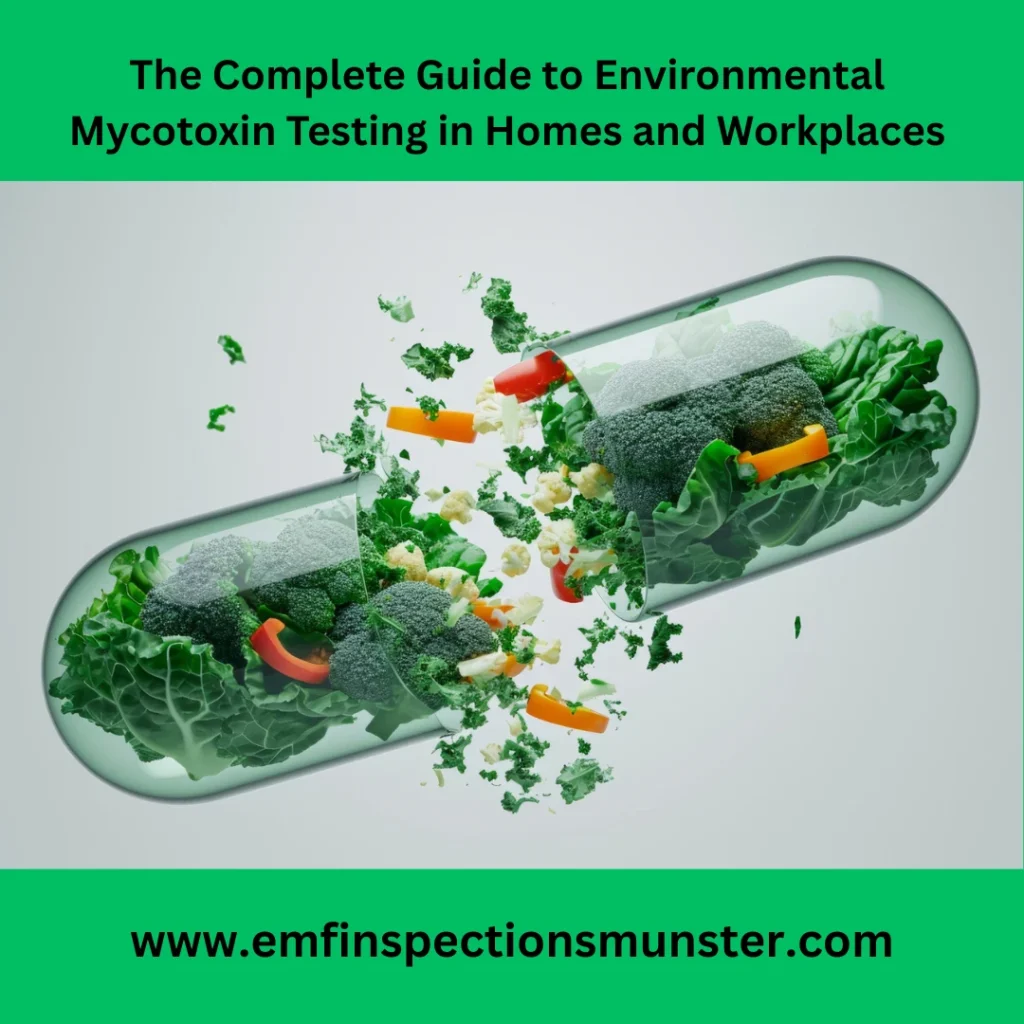Indoor environments are supposed to be safe havens. However, hidden dangers like mycotoxins—toxic compounds produced by certain types of mold—can silently impact our health, especially in spaces with poor ventilation or moisture issues. Whether you’re concerned about your home or workplace, environmental mycotoxin testing can be a crucial step in identifying and addressing contamination before it becomes a serious health concern.
This comprehensive guide will walk you through everything you need to know about environmental mycotoxins, the need for testing, how it’s done, and how to interpret results and act accordingly.
What Are Mycotoxins?
Mycotoxins are naturally occurring poisons generated by moulds (fungi) that develop on a variety of surfaces, especially in warm and humid environments. Commonly found in water-damaged buildings, these toxins can be airborne or exist in settled dust, infiltrating air systems and spreading throughout indoor spaces.
There are hundreds of identified mycotoxins, but the most harmful in indoor environments include:
- Aflatoxins
- Ochratoxins
- Trichothecenes
- Zearalenone
- Fumonisins
These toxins can compromise air quality and trigger or exacerbate numerous health conditions, particularly in individuals with weakened immune systems or respiratory issues.
Why Mycotoxins Are a Hidden Indoor Threat?
Unlike visible mould, mycotoxins are both unseen and odourless, making them almost difficult to identify without adequate testing. Yet, they are incredibly potent and can linger in the environment long after the original mold has been removed.
Exposure can lead to:
- Respiratory issues
- Chronic fatigue
- Headaches
- Neurological problems
- Immune suppression
- Allergic reactions
Long-term exposure, especially in workplaces or homes with ongoing moisture problems, can lead to more serious chronic illnesses and systemic inflammation.
The Importance of Environmental Mycotoxin Testing
The only way to determine if your space is contaminated with harmful mycotoxins is through environmental mycotoxin testing. It helps:
- Detect airborne or surface-bound mycotoxins
- Pinpoint hidden mold growth
- Verify the success of remediation efforts
- Prevent long-term health problems
- Protect vulnerable populations (e.g., children, the elderly, immunocompromised individuals)
In workplaces, testing also ensures compliance with health and safety standards, minimizing liability and safeguarding employee well-being.
Signs You May Need Mycotoxin Testing
Here are some red flags that indicate you may benefit from professional mycotoxin testing:
- Water damage to ceilings, floors, or walls, either past or present
- Persistent musty odors, even without visible mold
- Symptoms improve as you leave the location
- Visible mold, especially black mold (Stachybotrys)
- HVAC contamination or clogged air filters
- Condensation issues, particularly in basements or crawlspaces
Types of Environmental Mycotoxin Tests
Testing can be done using several methods depending on the goals and suspected severity of the contamination.
1. Air Testing
Air sampling is used to measure mycotoxins and mold spores floating in the air. It is particularly useful when mold isn’t visible but health symptoms persist.
2. Dust Sampling
Mycotoxins can settle in dust. Collecting and analyzing dust from floors, shelves, and HVAC systems helps identify long-term or past contamination.
3. Surface Sampling
Swab or tape-lift tests from walls, furniture, or vents are analyzed for toxins. These are useful for localized inspections or post-remediation verification.
4. Bulk Material Testing
Samples from insulation, drywall, or carpet can be collected and tested to find embedded mycotoxins in construction materials.
5. ERMI and HERTSMI-2 Testing
These are sophisticated DNA-based assays used to identify mould species that cause mycotoxins. Though not direct toxin tests, they can guide further targeted testing.
How does the Testing Process Work?
- Initial Assessment: A certified indoor environmental professional (IEP) conducts a walk-through and interviews occupants to understand symptoms and concerns.
- Sample Collection: Based on the assessment, samples are taken from air, dust, surfaces, or materials.
- Laboratory Analysis: The samples are sent to specialized labs that use methods like mass spectrometry or ELISA to detect and quantify mycotoxins.
- Report Generation: A detailed report outlines the types and levels of mycotoxins found, along with professional interpretations and remediation recommendations.
- Follow-up Testing: Post-remediation testing verifies that the problem has been completely remedied.
What Do Test Results Mean?
Mycotoxin reports can appear complex, but here’s how to interpret the basics:
- Non-Detect (ND): No detectable mycotoxins in the sample.
- Low to Moderate: Presence of mycotoxins, but possibly below harmful thresholds.
- High/Concerning: Immediate action needed. High levels of mycotoxins indicate an active or past severe mold infestation.
Because there are no universally accepted “safe” limits for indoor mycotoxins, interpretation often relies on professional judgment and contextual factors like health symptoms and building history.
Remediation After a Positive Test
If testing reveals a mycotoxin issue, remediation steps may include:
1. Identifying the Source
Using moisture meters, thermal cameras, and borescopes to find leaks or hidden mold behind walls or floors.
2. Addressing Moisture Problems
Fixing leaks, boosting ventilation, and installing dehumidifiers are all key steps in preventing mould recurrence.
3. Professional Mold Remediation
Certified mold remediation teams use negative air pressure, HEPA vacuums, and antimicrobial treatments to safely remove mold-infested materials.
4. Mycotoxin Decontamination
Standard cleaning is not enough—specialized cleaning agents, air purifiers, and fogging treatments may be used to neutralize residual toxins.
5. Post-Remediation Testing
Before reoccupying the room, final environmental mycotoxin testing is performed to ensure that the remediation is effective.
DIY Testing vs. Professional Testing
Some at-home kits are available for testing mold and mycotoxins. While convenient, they often lack accuracy and don’t offer the detailed insights or support that come from working with certified professionals.
Professional testing offers:
- Accurate identification of mycotoxin types and levels
- Expert recommendations for mitigation
- Legal documentation (important for landlords or insurance claims)
- Proper chain-of-custody to avoid contamination or error
Preventing Future Contamination
To maintain a toxin-free indoor environment, consider these preventive steps:
- Control humidity levels (ideally 30–50%)
- Repair leaks immediately
- Use mold-resistant materials in high-moisture areas
- Maintain HVAC systems and replace filters regularly
- Clean air ducts every 3–5 years
- Use HEPA air purifiers in vulnerable spaces
Regular inspections and occasional environmental mycotoxin testing—especially after any flooding or water damage—will help keep your indoor air safe.
Conclusion:-
Understanding the hidden danger of mycotoxins is the first step to protecting your health and ensuring your living or working space is truly safe. Whether you’re dealing with persistent health symptoms, unexplained odors, or a known history of water damage, environmental mycotoxin testing provides invaluable peace of mind.
And remember, environmental toxins rarely exist in isolation. In some regions like Cork, for example, additional indoor hazards such as harmful EMF exposure may compound the health risks. A holistic approach to indoor environmental health—addressing mold, mycotoxins, and harmful EMF Cork—can ensure a healthier, more productive environment for all occupants.
Frequently Asked Questions:-
1. What is environmental mycotoxin testing?
- Environmental mycotoxin testing is a method used to detect and measure toxic substances called mycotoxins, which are produced by certain molds. These toxins can be found in the air, dust, or on surfaces within indoor environments. Testing helps determine if a home or workplace is contaminated and provides crucial information needed to take corrective action to protect the health of occupants.
2. How do I know if my home or workplace needs mycotoxin testing?
- You may need mycotoxin testing if you’ve experienced any water damage, noticed persistent musty odors, or if occupants are suffering from ongoing health issues that seem to improve when they’re away from the property. Visible mold growth or a history of mold problems are also strong indicators that testing may be necessary.
3. What types of samples are used in mycotoxin testing?
- Mycotoxin testing involves collecting samples from various parts of the environment, such as indoor air, household dust, and contaminated surfaces. In some cases, materials like drywall or carpet are tested to check for toxins embedded in building components. These samples are then analyzed in a laboratory to determine the presence and levels of mycotoxins.
4. Can I do mycotoxin testing myself, or do I need a professional?
- While there are home testing kits available, they often lack the accuracy and detailed interpretation that a certified professional can provide. A professional will ensure proper sample collection, deliver reliable results, and offer expert guidance on how to address any issues found during testing.
5. What should I do if my test results show high levels of mycotoxins?
- If your test results indicate high levels of mycotoxins, it’s important to act quickly. The first step is to locate and eliminate the source of moisture that is allowing mold to thrive. From there, professional mold remediation may be necessary to remove contamination. Specialized cleaning and follow-up testing will confirm that the environment is safe before reoccupation.


